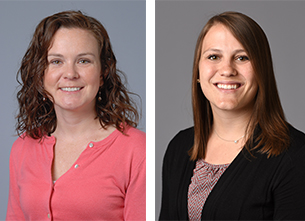Indiana LEND Faculty Receive Grant to Increase Access
October 21, 2019

|
| (L-R) Maura Rouse, PsyD, HSPP and Brett Enneking, PsyD, HSPP |
Previous LEND trainees and current Indiana LEND faculty, Maura Rouse, PsyD, HSPP and Brett Enneking, PsyD, HSPP, were recently awarded grant funding for their project to bring the telehealth model of care into the Indiana University/Riley Hospital for Children LEND clinic. Their project builds on previous care coordination research demonstrating that families need continued education and support related to diagnosis (e.g. autism spectrum disorder, intellectual disability) and treatment following their child's initial evaluation. As Riley Hospital for Children at Indiana University is one of the premier care centers for children with neurodevelopmental disabilities in the state of Indiana, approximately 68% of the families travel more than an hour to receive this high quality care for their child.
Research supports integrating telehealth technology into healthcare practice. Clinicians are realizing the importance of tailoring telehealth treatment to everyone. Researchers emphasize that nonverbal and verbal communication help to develop a strong provider-patient relationship, which subsequently improves patient care. The addition of a "virtual visit" to the LEND treatment protocol will allow providers and families to connect both verbally and nonverbally. Providers (i.e. psychologists and social workers) will work with families at the clinic on the day of the patient's evaluation to determine if families prefer to use a "virtual visit" or a telephone call for their subsequent care-coordination visit. During the "virtual visit" (i.e. the study's treatment group), the LEND team will talk with the family about any questions they have related to diagnoses, services, and recommendations made by the evaluation team. A few primary aims of the study are to determine if virtual visits increase family satisfaction compared to phone calls and to compare costs and reimbursement for phone versus virtual visits.







